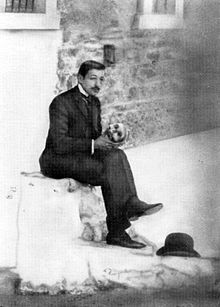George N. Papanicolaou
George Nicholas Papanicolaou ( Greek Γεώργιος Νικολάου Παπανικολάου Georgios Nikolaou Papanikolaou ; born May 13, 1883 in Kymi on Euboea , Greece ; † February 19, 1962 in Miami , USA ) was a Greek pathologist .
Life
George N. Papanicolaou was born in Euboea as the son of the doctor Nikolaos Papanikolaou . As a gifted student he was sent to Athens and attended the National and Kapodistrian University of Athens , where he received his medical degree in 1904 at the age of only 21. Then he did his military service. Although he did not comply with the family's wish to work as a military doctor from now on, they supported him financially in starting a doctoral degree in biology in Germany . After brief positions in Jena and Freiburg , he went to the Ludwig Maximilians University in Munich , where he received his doctorate in 1910. While in Greece he was still toying with the idea of becoming a musician, since he played the violin well, his primary interest in Germany was philosophy. He studied the writings of Immanuel Kant and Arthur Schopenhauer and above all those of Nietzsche . Ultimately, it was the immersion in philosophy that kept him from ever becoming a practicing doctor.
He then went to Athens, where he married his fiancée Andromachi Mavrogeni. In 1911, George Papanicolaou accepted an invitation to work at the Oceanographic Institute in Monaco . With the outbreak of the First World War, research almost came to a standstill. He decided to register as an emigrant to the USA. When he arrived in New York, he initially worked as a journalist for a Greek-language newspaper. The family did not have children for the time being so that both had enough time for research together. Papanicolaou's wife also refrained from being named as a co-author of joint publications, with the idea that one person could do more than two in public. George Papanicolaou successfully applied for a job at New York Hospital , where he initially worked as a pathologist.
In 1916 he began working in the gynecological department at Cornell University , where he began his research.
research
Its most important development was the so-called Papanicolaou smear (short: Pap smear or Pap test), with which an early cytological diagnosis of cervical cancer was possible in series examinations . Papanicolaou carried out the smear for the first time in 1923, but did not publish the results until 1928.
In 1923 he was at the Cornell University New York appointed Assistant Professor and in 1937 promoted to associate professor in 1947 where his appeal to the ordinary (full) was made professor and he director of the Department of Clinical Anatomy was.
The frequency of detection and treatment of cervical cancer has increased significantly as a result of the introduction of the Pap test in gynecological practice, and mortality from cervical cancer has decreased by two thirds.
This examination is still carried out routinely by gynecologists today. With this simple and inexpensive method, the incidence of cervical cancer was and can be significantly reduced, especially by recognizing the early, not yet invasive and easily surgically removable preforms. It also reduced the radical nature of the necessary operation.
He died of a heart attack in Miami, Florida in 1962 and was buried in New Jersey .
Awards and honors
- Papanicolaou was awarded the Amory Prize of the American Academy of Arts and Sciences in 1947 .
- In 1950 he received the Albert Lasker Award for Clinical Medical Research .
- The last banknote of the Bank of Greece and the largest in terms of face value was dedicated to Papanicolaou and the Pap smear; he was the only 20th century personality on a Greek banknote.
- On May 13, 2019, for the 136th birthday, Papanicolaou was honored by Google with a global doodle.
Fonts
- New Cancer Diagnosis. In: Proceedings of the third Race Betterment Conference, January 2-6, 1928. Race Betterment Foundation, Battle Creek MI 1928, pp. 528-534.
- with Herbert F. Traut: Diagnosis of Uterine Cancer by the Vaginal Smear. The Commonwealth Fund, New York NY 1943.
literature
- D. Erskine Carmichael: The Pap Smear. Life of George N. Papanicolaou. Thomas, Springfield IL 1973, ISBN 0-398-02716-1 .
- Peter Schneck: Papanicolaou, George Nicholas. In: Werner E. Gerabek , Bernhard D. Haage, Gundolf Keil , Wolfgang Wegner (eds.): Enzyklopädie Medizingeschichte. De Gruyter, Berlin / New York 2005, ISBN 3-11-015714-4 , p. 1096.
Web links
- Whonamedit: George Nicholas Papanicolaou
- George N. Papanicolaou in the database of Find a Grave (English)
Individual evidence
- ^ Peter Schneck: Papanicolaou, George Nicholas. 2005, p. 1096.
- ↑ PAP test (cancer smear), accessed January 15, 2015
| personal data | |
|---|---|
| SURNAME | Papanicolaou, George N. |
| ALTERNATIVE NAMES | Papanicolaou, George Nicolas; Papanikolaou, George Nicolas; Παπανικολάου, Γεώργιος Νικολάου (Greek) |
| BRIEF DESCRIPTION | Greek-American doctor and pathologist |
| DATE OF BIRTH | May 13, 1883 |
| PLACE OF BIRTH | Kymi , Evia, Greece |
| DATE OF DEATH | 19th February 1962 |
| Place of death | New Jersey , USA |
